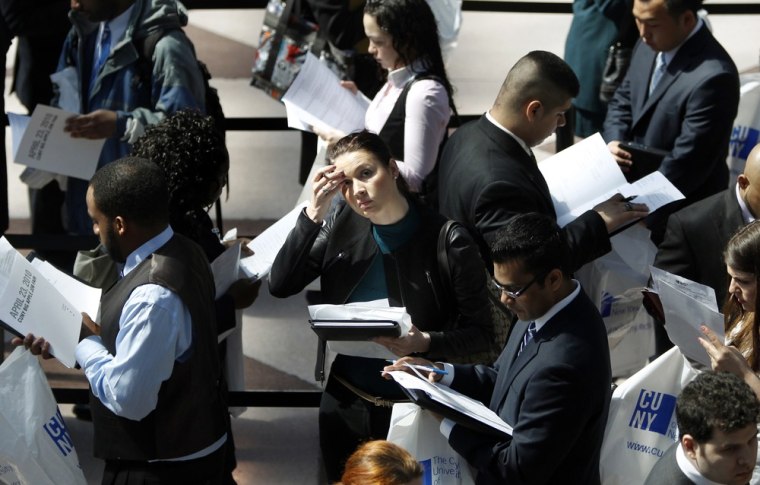The U.S. labor market is finally improving, just when many of the other economic indicators are wavering.
Jobs are considered a lagging indicator. They typically recover many months after the economy comes out of a recession, and this cycle was no exception. So will troubles in Japan, Libya and elsewhere push up U.S. unemployment later this year?
"The U.S. economy is headed for another soft patch brought on by the double shock," said IHS Global Insight chief economist Nariman Behravesh, referring to Japan and upheaval in the oil-producing Arab world.
Assuming oil prices stabilize and Japan's reconstruction and recovery begin in the next few months — as most economists currently expect — Behravesh says the soft patch will likely be short-lived. If he's right, the impact on the labor market should be minimal.
Friday brings the March employment report, and economists polled by Reuters are looking for growth of about 188,000 jobs, with the unemployment rate holding steady at 8.9 percent.
This employment report carries a bit more uncertainty than usual because it arrives before some of the early indicators economists rely on to fine-tune their forecasts.
Normally, the jobs report is released after the monthly Institute for Supply Management readings on manufacturing and services, both of which contain employment measures.
Not so this time.
The ISM manufacturing survey comes out on Friday, about 90 minutes after the jobs data, and the services report won't be released until the following week.
That leaves Thursday's weekly jobless claims report as the best guide, and the trend there has been "heartening," said Deutsche Bank economist Brett Ryan.
He said payrolls historically have not turned significantly higher until weekly jobless claims broke below the 400,000 barrier. The four-week moving average, which smooths out weekly volatility, has been below that threshold in four of the past five weeks.
That makes him a bit more optimistic than most about Friday's employment figures. He thinks they will show a gain of 200,000 jobs, with the unemployment rate dipping to 8.8 percent
Even with the benefit of all the early clues, economists have not had much success in predicting the jobless rate in recent months. It has fallen by more than expected in each of the prior three months, coming down nearly a full percentage point since November. Indeed, the labor market has been among the few positive surprises lately.
Paul Ashworth, an economist with Capital Economics in Toronto, said the U.S. economy "appeared to have everything going for it headed into the new year" before the run-up in food and energy prices and the Japanese earthquake.
"Ironically, the labor market is the only part of the economy still showing any unequivocal signs of improvement," Ashworth said.
Many economists have downgraded growth prospects for the first quarter, partly because of rising oil prices that threaten to curtail consumer spending.
Between the Middle East and North Africa unrest, Japan's disaster and Portugal's deepening debt troubles, global trouble zones have multiplied.
Most of them have a connection to oil.
Friday's ISM reports will offer more insight into how the global economy is coping so far. Even before Japan's earthquake and tsunami, rising food and energy prices were driving up business costs, and that pattern is likely to persist.
The European Central Bank has warned that it is keeping a close eye on inflation pressures and would not hesitate to raise interest rates.
For most central bankers, what matters most is how consumers react to those rising prices, so Wednesday's reading on euro zone consumer inflation expectations bears watching. A similar gauge of U.S. consumer expectations indicated they were edging up modestly in March.
U.S. consumer confidence measures clearly show rising gasoline prices have darkened shoppers' moods. But that has not yet translated into a perceptible drop in spending.
That could be because of the improving jobs picture. When people feel confident that paychecks will keep coming in regularly, paying a bit more at the gasoline pumps isn't quite so unsettling. When customers keep coming through the door, employers are more inclined to hire.
It's a bit of a chicken-and-egg problem, but as long as spending holds up, the labor market should too.
